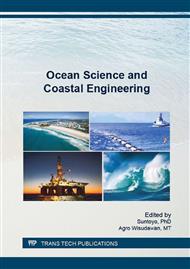p.138
p.144
p.154
p.161
p.168
p.174
p.182
p.189
p.197
Development Efforts of Coastal Community after Lapindo Mud Flow
Abstract:
Lapindo is waste disposal the mud that comes out of the PT. Lapindo Brantas.Inc in Porong, Sidoarjo East Java, which has lasted for more than 9 years ago. With the volume bursts of 105 m3/day and take time to stop bursts estimated at 8907 years. This sludge can affect surrounding communities. The purpose of this research is to the development of coastal communities in Jabon post Lapindo mudflow, by using Analytical Hierarchy Process (AHP) Data collected through questionnaires, interviews, observation and documentation. In empowering coastal communities Jabon there are three actors involved, government Sidoarjo, PT Lapindo Brantas Inc., and coastal communities Jabon. To determine the parties involved. The most appropriate use of sub-criteria to support the main criteria. From the results obtained the most demanded by the public as a result of the government's disaster PT. Lapindo Brantas Inc. The effects of the mudflow society expects improvement, especially in terms of the economy of coastal communities Jabon.
Info:
Periodical:
Pages:
168-173
Citation:
Online since:
January 2017
Authors:
Keywords:
Price:
Сopyright:
© 2017 Trans Tech Publications Ltd. All Rights Reserved
Share:
Citation:


